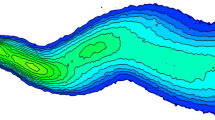Abstract
The pollutant transportation process in turbulent wakes is studied experimentally using planar laser-induced fluorescence (PLIF). The concentration fields in the very near wake region behind typical bluff bodies are measured for steady flow. The characteristics of the mean and instantaneous concentration fields behind circular and sinusoidal islands and peninsulas are investigated. The results indicate that the pollutant distribution is closely related with the unsteady vortex shedding in the flow field. Compared with that of the circular island, more pollutants enter into the wake generated by the sinusoidal-shaped island. The time needed for pollutants to accumulate in or drain out of the wake region after the peninsula before reaching a relatively constant value is longer than that for the islands, regardless of the island or peninsula shape. The results will facilitate pollutant control behind sea islands and other natural or man-made structures in water. Also the results provide some fundamental data for checking numerical models.
Similar content being viewed by others
Author information
Authors and Affiliations
Additional information
Received: 11 November 2000/Accepted: 26 January 2001
Rights and permissions
About this article
Cite this article
Jiang, C., Li, Y., Li, Y. et al. Experimental study of steady concentration fields in turbulent wakes. Experiments in Fluids 31, 269–276 (2001). https://doi.org/10.1007/s003480100282
Issue Date:
DOI: https://doi.org/10.1007/s003480100282




